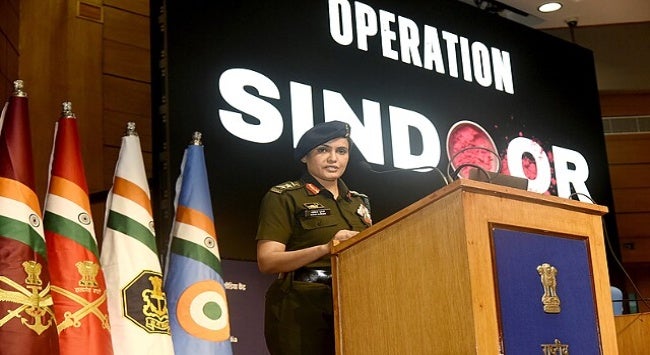Summary
In the early hours of 7 May 2025, India launched a military offensive named Operation Sindoor, which targeted multiple sites in Pakistan and Pakistan-administered Kashmir. Pakistan’s swift retaliation, including claims of downing five Indian warplanes, has thrust South Asia into a new and perilous phase of brinkmanship. The tensions have not only intensified military hostilities but also exposed the erosion of diplomatic norms and crisis management mechanisms that previously helped contain escalation between the two nuclear-armed neighbours.
In the early hours of 7 May 2025, India launched a military attack it called Operation Sindoor, striking multiple locations in Pakistan and Pakistan-administered Kashmir. The strikes, justified by New Delhi as targeting “terrorist infrastructure” linked to the 22 April 2025 Pahalgam attack that killed 26 civilians, marked the most serious escalation between the two nuclear-armed neighbours since 2019. As details continue to emerge, the strikes and Pakistan’s response have plunged the region into a volatile new chapter and exposed the growing risk of uncontrolled escalation.
India’s Ministry of Defence stated that the strikes were “focused, measured, and non-escalatory” and laid an emphasis on avoiding Pakistani military targets. Yet reports from Islamabad paint a very different picture. According to Pakistan’s Inter-Services Public Relations (ISPR), Indian missiles hit six locations across Punjab and Azad Jammu and Kashmir, including populated civilian areas and at least three mosques. According to ISPR Director General Lieutenant General Ahmed Sharif Chaudhry, speaking at a press briefing, the strikes resulted in the deaths of 26 people and injured 46 others. In Bahawalpur, a three-year-old was among five civilians killed when Subhan Mosque was struck four times. Other reported sites of impact included Kotli, Muzaffarabad and Muridke. The full extent of the damage, the accuracy of reported figures and the gravity of the impact are likely to become clearer in the coming days as more information emerges.
In the immediate aftermath of India’s Operation Sindoor, Pakistan launched a swift military retaliation. Information Minister Attaullah Tarar announced the downing of two Indian jets. Three more were later confirmed by Dawn newspaper. Pakistan further claimed to have destroyed an Indian drone, multiple checkposts and an Indian brigade headquarters in retaliatory strikes. These actions were accompanied by ongoing exchanges of fire along the Line of Control. That Indian strikes targeted Pakistani civilians were used to invoke Article 51 of the United Nations (UN) Charter to justify Pakistan’s military response as an act of self-defence. Ultimately, Prime Minister Shehbaz Sharif promised that “a resolute response is already underway”. Domestically, Pakistani authorities implemented emergency measures in response to the strikes, including school closures across Punjab, heightened hospital alerts, and the convening of the National Security Committee.
The international response to the crisis was marked by alarm, with repeated calls for restraint and urgent appeals for de-escalation. United States (US) President Donald Trump called the situation “a shame”, noting the long history of conflict between the two countries and expressing hope that “it ends very quickly”. The UN Secretary-General António Guterres issued a stern warning that “the world cannot afford a military confrontation between India and Pakistan.” Several major powers echoed similar appeals for restraint, with the United Kingdom, China, Russia, France and the United Arab Emirates urging both India and Pakistan to ease tensions.
Concurrently, Pakistan activated diplomatic channels to internationalise the crisis. Its Permanent Representative to the UN Asim Iftikhar Ahmad formally briefed the UN Security Council, characterising the Indian strikes as a threat to regional peace and stability. Meanwhile, India’s National Security Adviser Ajit Doval briefed his American counterpart, which signalled a parallel diplomatic contest over the framing of events.
What distinguishes this crisis is not only the military intensity but also the unravelling of diplomatic norms that once served as guardrails. India’s move to suspend the Indus Waters Treaty and Pakistan’s threat to abandon prior agreements mark a shift into uncharted diplomatic terrain. Unlike past episodes, such as the 1999 Kargil conflict, where hostilities were largely confined to unpopulated mountainous zones, this escalation has already produced civilian casualties, thereby fundamentally altering the stakes.
What happens next remains uncertain. While neither government may seek a full-scale war, their public statements signal readiness to escalate if necessary. Both are also constrained by domestic political pressures and entrenched narratives of national pride and sovereignty. Pakistan’s Defence Minister Khawaja Asif warned that “If they (India) impose an all-out war on the region and if such dangers arise in which there is a standoff, then at any time a nuclear war can break out”. In such a charged environment, even calibrated moves risk being misread. The danger, in other words, lies in miscalculation, where one side’s attempt to “signal strength” could be read as a provocation demanding further retaliation.
As regional airspace remains restricted, civilians bury their dead and diplomats scramble behind the scenes, 7 May 2025 may well be remembered as the day South Asia stood on the edge again.
. . . . .
Dr Imran Ahmed is a Research Fellow at the Institute of South Asian Studies (ISAS), an autonomous research institute at the National University of Singapore (NUS). He can be contacted at iahmed@nus.edu.sg. The author bears full responsibility for the facts cited and opinions expressed in this paper.
Image: Wikimedia commons
-
 More From :
More From :
-
 Tags :
Tags :
-
 Download PDF
Download PDF



